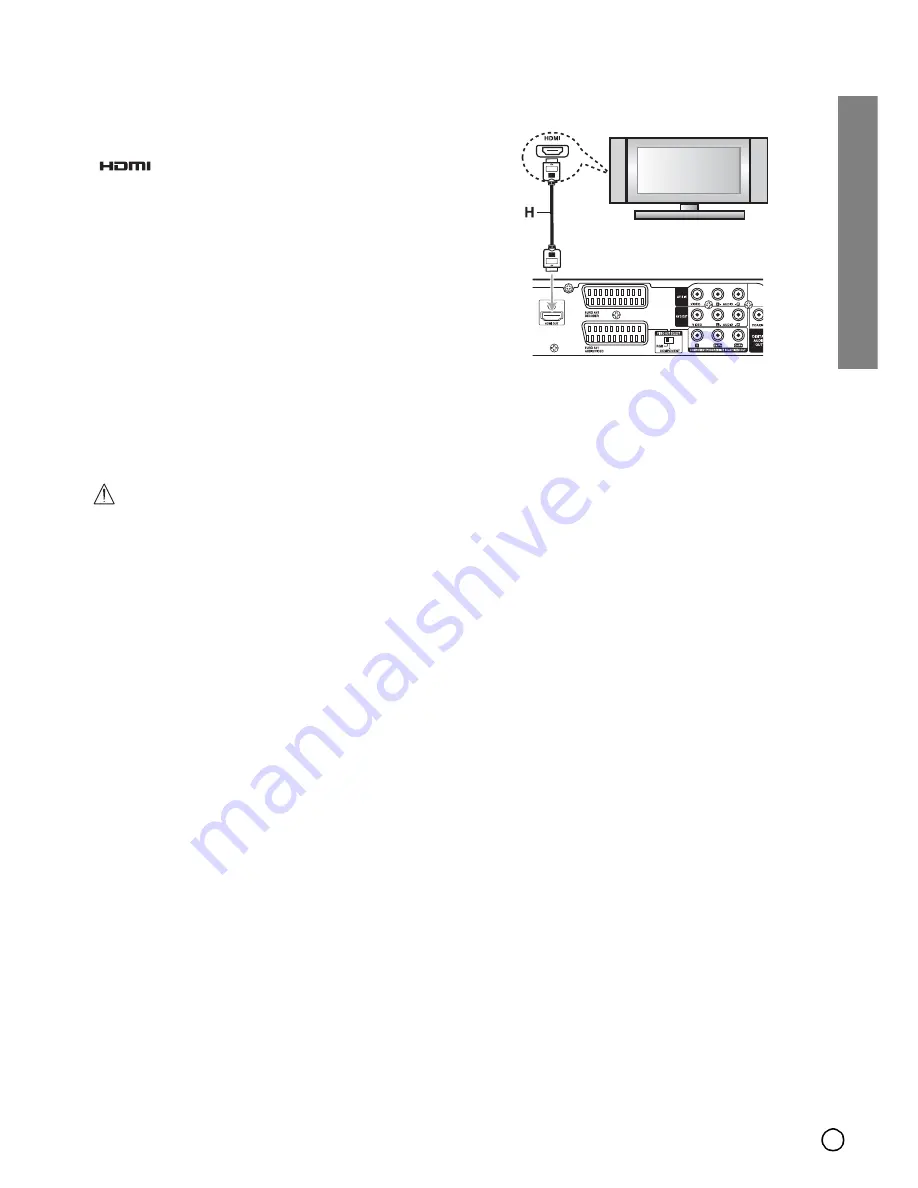
15
H
o
ok
up and
Se
tti
ngs
HDMI connection
If you have a HDMI TV or monitor, you can connect it to
this recorder using a HDMI cable.
Be sure to use an HDMI cable with HDMI logo
(
).
1. Connect the HDMI jack on the recorder to the HDMI
jack on a HDMI compatible TV or monitor (H).
2. Set the TV’s source to HDMI (refer to TV’s Owner’s
manual).
Tip:
When you use HDMI connection, you can change the
resolution (576i, 576p, 720p, or 1080i) for the HDMI
output using RESOLUTION button. (See pages 11, 12)
Press the RESOLUTION button once to show the
current setting in the display window on the front of the
unit. Pressing the RESOLUTION button again within
about 2 seconds switches the resolution setting in the
following order: 576i
→
576p
→
720p
→
1080i.
• When the resolution is set to 720p or 1080i, the TV
Aspect setting on the Setup menu is fixed at “16:9”.
Caution
• Some TVs with HDMI interface do not support
“Progressive Scan OFF mode: 576i”. If no image
appears when the HDMI connectors on recorder and
the TV are joined, connect the analog VIDEO OUT
jack to the video input on TV, in order to display the
image through the recorder. Then press the
RESOLUTION button on the front of the unit
repeatedly until the image appears.
• Changing the resolution when the recorder is
connected with HDMI connector may result in
malfunctions. To solve the problem, turn off the
recorder and then turn it on again.
Notes:
• If your TV is NOT capable of handling 96 kHz
sampling frequency, set the [Sampling Freq.] option
to [48 kHz] on the setup menu (See page 23).
When this choice is made, this unit will automatically
convert any 96 kHz signals to 48 kHz so your system
can decode them.
• If your TV is not equipped with Dolby Digital and
MPEG decoder, set the [Dolby Digital] and [MPEG]
options to [PCM] on the setup menu (See page 23).
• If your TV is not equipped with DTS decoder, set the
[DTS] options to [OFF] on the setup menu (See
page 23). To enjoy DTS multi channel surround, you
must connect this recorder to a DTS compatible
receiver via one of this recorder’s digital audio
outputs.
• The arrow on the cable connector body should face
up for correct alignment with the connector on the
recorder.
• If there is noise or lines on the screen, please check
the HDMI cable.
About HDMI
HDMI (High Definition Multimedia Interface) supports
both video and audio on a single digital connection for
use with DVD Players, Set-Top Boxes, and other AV
devices.
HDMI was developed to provide the technologies of
HDCP (High-bandwidth Digital Content Protection).
HDCP is used to protect digital content transmitted and
received.
HDMI has the capability to support standard,
enhanced, or high-definition video plus standard to
multi-channel surround-sound audio, HDMI features
include uncompressed digital video, a bandwidth of up
to 5 gigabytes per second, one connector (instead of
several cables and connectors), and communication
between the AV source and AV devices such as DTVs.
HDMI, the HDMI logo and High-Definition Multimedia
Interface are trademarks or registered trademarks of
HDMI licensing LLC.
Additional Information for HDMI
• When you connect a HDMI or DVI compatible device
make sure of the followings:
– Try switching off the HDMI/DVI device and this
recorder. Next, switch on the HDMI/DVI device and
leave it for around 30 seconds, then switch on this
recorder.
– The connected device’s video input is set correctly
for this unit.
– The connected device is compatible with
720(1440)×576i, 720×576p, 1280×720p, or
1920×1080i video input.
• Not all HDCP-compatible DVI devices will work with
this recorder.
– It’s impossible copy protected-DVD title’s playback
in non-HDCP devices.
Rear of the recorder
HDMI compatible TV
Содержание DV-DS163E
Страница 1: ......
Страница 68: ...68 PUBLISHED BY THE BRITISH BATTERY MANUFACTURERS ASSOCIATION 7 BUCKINGHAM GATE LONDON SW1E 6JS ...
Страница 69: ...69 Reference ...
















































